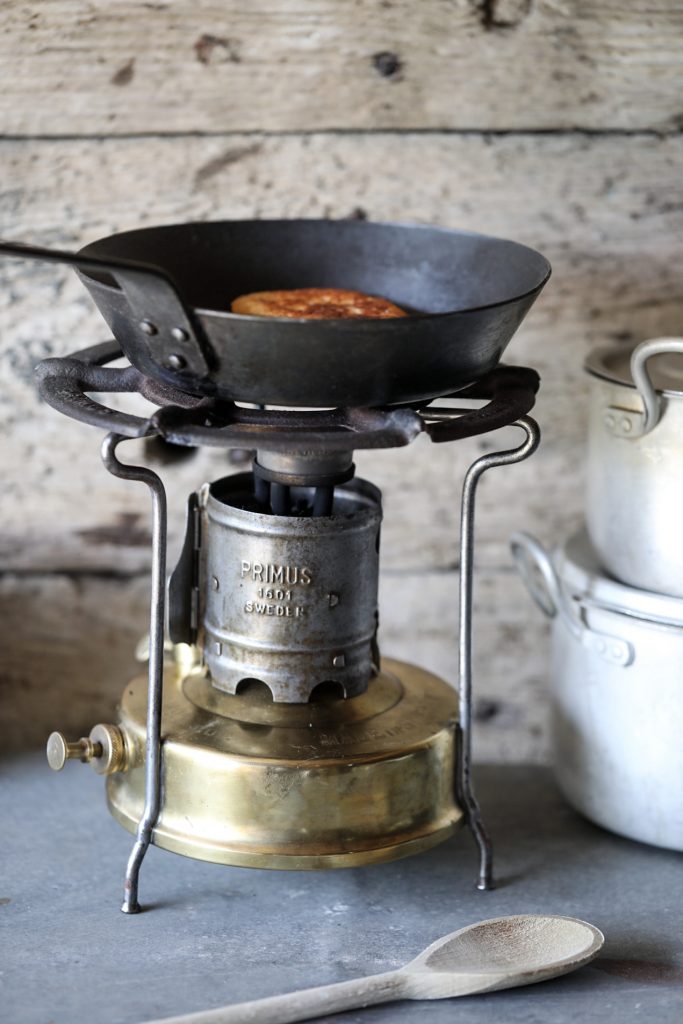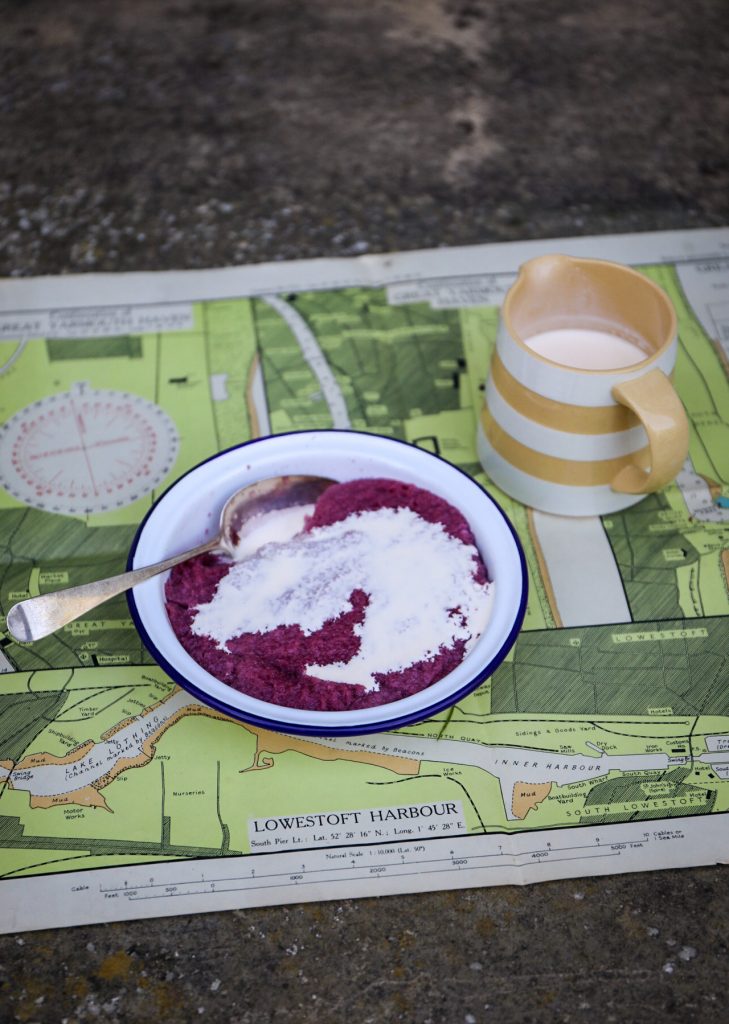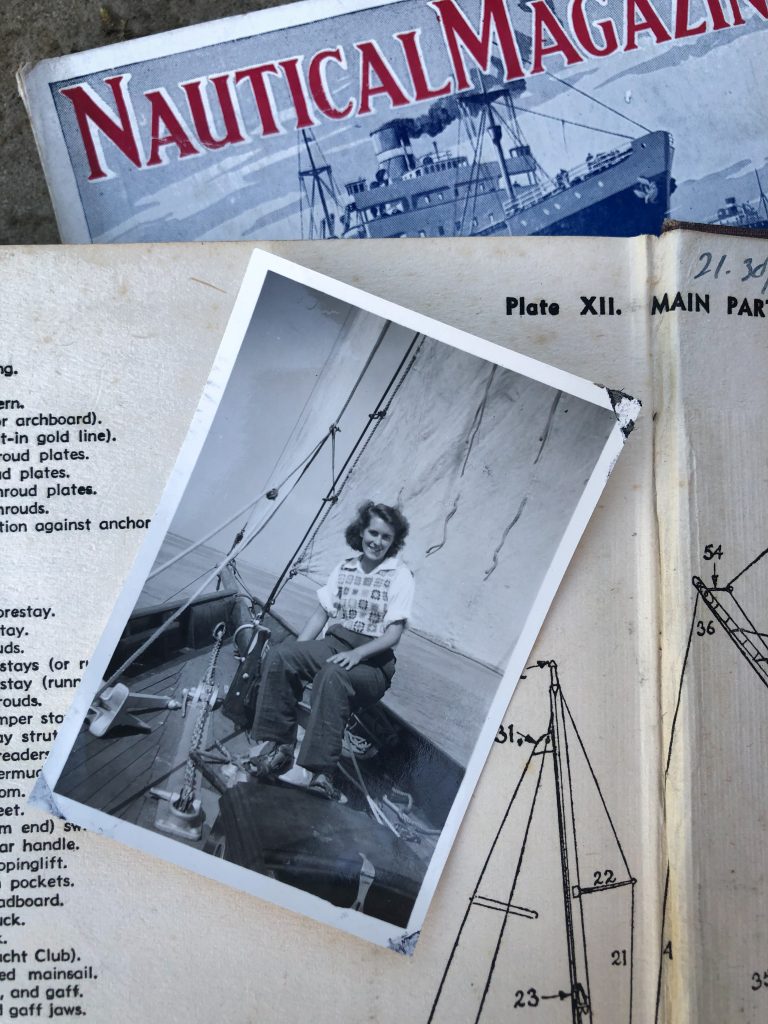Cookery For Small Craft

By D. Stobart Russell. Published by Black & Son, Ltd., Glasgow in 1946.
Ahoy there shipmates! It is a beautiful May day in 1946. We have sunshine and a fair wind, so we’re casting off our moorings and venturing up the coast for a bracing few days aboard Walter’s new motor cruiser. Most important matters first, what will the dining arrangements be?
“How much comfort and happiness at sea, in a big ship or small, depends upon the working of the galley department” warns T.N. Dinwiddy in his foreword to Cookery for Small Craft. He can certainly be viewed as an authority on such matters, being as he is, Vice-Commodore of the Royal Cruising Club.
Indeed, the galley (the ship’s kitchen) could be considered to be the most important part of a cruising vessel, below decks. You can put up with a hard bunk, a drip from the deck onto your pillow. You might even put up with a mate who smokes a foul pipe; but only if your galley produces good, hot meals, as and when required.
Never fear though, we are in safe hands. Mrs Russell, (greatly experienced both as a navigator and seaman in small yachts, in all seasons) is here to advise and reassure with this helpful little book. She has a full appreciation of how a ship’s galley should be organised and it is her aim to show that the preparation of a good, fresh meal “need not be much more arduous than heating something out of a tin.”
In fact, I suspect that canned goods might be a bit of a bugbear for our author. Whilst she admits that “many very excellent things come out of tins” she is at pains to point out that they should merely be acting as a useful adjunct to the ship’s larder and not forming the basis for every meal. “Having used up our fresh meat, do we now put away our cookery book and return to our tins? No we do not.”
Ideally the galley will be aft (towards the stern – the back part of the vessel) and close to the hatch so that steam and cooking odours can escape quickly, rather than permeating the whole ship. The lighting, both day and artificial, should be good because when a person is forced to cook in a dim twilight, feelings can “quickly become murderous.”
Of course, the galley must be well arranged, having accommodation within easy reach for pots, pans, cooking utensils, plates, dishes, oven cloths and so on. Indeed, there must be a place for everything and everything must be kept in its place.
A list of recommended equipment includes two or three sizes of saucepan that can be stowed inside one another (the largest being able to take a chicken comfortably) a frying pan, a kettle, an iron girdle and a couple of asbestos mats to protect your surfaces (the association between asbestos and serious lung disease unfortunately not having yet been made at the time this book was published). The stove “should be of a type that is easy to clean, that does not smell and does not black the pans. (Any stove that persistently offends in this last respect should be hove overboard.)”

As well-prepared sailors, we ought to be amassing provisions for a passage taking three times as long as expected and will bear in mind when selecting what to take, that there is no cool larder to make use of on board our little ship.
Essential fresh ingredients include butter, eggs – “If there is one dish that might have been invented for the small-craft yachtsman, it is the Omelet,” bacon, “(hung up in muslin it will keep for a good long time)” and cheese, although “high-smelling varieties do not make good shipmates, and the Camembert may give you some uneasy moments as to the state of your bilge before you trace the strange odour to its source).”
The obvious advantage of living on the sea is that really fresh fish is easily obtainable either by one’s own efforts or from a fisherman; “and to eat fish that has passed straight from his watery home to the cook’s hands is a very different thing to consuming his ice-flabby brother from the fishmonger’s slab.”
Onto non-perishable ingredients. An extensive list of recommended provisions is given, including suet, flour, rice, sago, dried beans and peas, lentils, coffee, tea, cocoa, slab chocolate, sugar, dried fruits and nuts, bottled olives and all manner of condiments.
Tinned foods deemed to be permissible include soups, “the Cream ones being the most sustaining,” sardines, corned (Bully) beef, baked beans, spaghetti, tongues, vegetables, fruit and condensed milk. Mrs Russell even ventures to suggest that luxuries such as a tin of pâté de foie gras might not go amiss, “dependent on the size of one’s lockers and the extent of one’s purse,” of course.
It goes without saying that a supply of fresh fruit and vegetables on board are essential to the good health of the crew. However, the boiling of certain greens, such as cauliflower and cabbage, is apt to “permeate the place with steam and an objectionable odour which clings for hours.” It is recommended that these be avoided as an accompaniment to meals, except when alternatives are unavailable. Potatoes, onions, peas, carrots, tomatoes and peppers are all acceptable though. As for garlic “if the cook uses this with discretion and avoids arousing prejudice by the undue advertisement of its presence, it will rarely be recognised as garlic and the new flavour will be appreciated, especially with mutton or pork.”
A bottle of wine should always be at hand for cooking – “for the cost of a few pence a dish a Cordon Bleu reputation will be gained.” Hopefully there will be enough for the cook to take a sneaky swig every now and then too.
As a finishing touch to a well-provisioned galley, Mrs Russell recommends “three large thermos flasks standing in their own rack in some easily accessible place. Before starting on a passage these should always be filled with soup, tea and either Horlicks’ Malted Milk, cocoa, or any other “food” drink of that type preferred, thus rendering a cup of something hot available at a moment’s notice under all conditions.” This sounds like incredibly sound advice.
Finally, let us not forget washing up, the necessary, if unpopular, sequel to every meal. “Your water (either fresh or salt) must be hot. Wash non-greasy things such as cups, teaspoons, &c., first, and then in the following order – spoons and forks, plates (previously wiped with paper if very dirty) knives, and lastly cooking pans.” We are advised not to throw away our coffee grounds because apparently they are of great assistance when it comes to the cleaning of greasy pans. “You simply put them into the utensil to be cleaned, heat and rub around with paper, and they will absorb all the fat; a final polish with a clean piece of paper should then be all that is required.” I don’t know about you, but I have my doubts about this particular piece of wisdom. In my experience, loose coffee grounds have a mind of their own and are one of the hardest things ever to clear up, (and that’s with ample supplies of water on tap).
The remainder of the book is devoted to recipes. By necessity they are all uncomplicated and reasonably quick to prepare. Simple soups, various meat and fish dishes, boiled, braised, fried or steamed (for we have no oven) and one or two salads and dressings. Mrs Russell does not give many recipes for puddings, assuming we will have brought with us a nice big fruit cake to cut at as needs be, or perhaps a biscuit box full of “really good pastries.” However, she admits, there are occasions when “the larder is low or the first course consists of cold meat, or appetites are unusually fierce, and then a pudding is desirable.”
Raspberry Bread

Ingredients
Raspberry, loganberry or blackberry juice from 1 large tin fruit, 1 small stale white loaf, 2 tablespoons Maraschino or other liqueur (optional), sugar as required.
Method
Heat the fruit juice and sugar. Cut the bread into thick slices, having removed the crust, and arrange in a bowl or deep dish. Pour the hot fruit juice over the bread and allow to cool, basting from time to time. Add liqueur, if liked, serve with cream.
If Heinz made Summer Pudding for babies, it would be exactly this (minus the Maraschino Liqueur, of course). A not entirely unpleasant, raspberry flavoured bready pap, without the inconvenience of any pips to get stuck in your teeth. I feel this would make good invalid food. And, as always, it is even better accompanied by cream.
And what of freshly baked goods, you ask? Never fear, the last chapter of Cookery For Small Craft is devoted to the art of Girdle cooking. Armed with a girdle (a round, thick, iron sheet that can be hung above your cooker flame) you can easily make delicious, crusty, flat breads and countless varieties of hot cakes.
As long as none of us suffers from sea sickness, I think our little sojourn on the ocean will be just fine.
